For many people, creating and holding a presentation involves a great deal of effort. It even leads to buck fever. To make matters worse, if the presentation has to be given in English, it often entails double the effort for native German speakers. We want to make your next presentation a bit more effortless by introducing the most useful phrases and expressions for an English-language performance.
Presentations have the advantage that many standard phrases can be used at various points. Perhaps you wish to welcome the audience, introduce the speaker and the topic, outline the structure, offer a summary, or deal with questions. In all these situations, you can apply a number of useful expressions that will make your presentation a linguistic success.
Welcome
At the beginning of each presentation, you should welcome your audience. Depending on who you are addressing, you should extend a more or less formal welcome.
Good morning/afternoon/evening, ladies and gentlemen/everyone.
On behalf of “Company X”, allow me to extend a warm welcome to you.
Hi, everyone. Welcome to “Name of the event”.
Introducing the speaker
The level of formality of your welcome address will also apply to how you introduce yourself. Customize it to match your audience.
Let me briefly introduce myself. My name is “John Miller” and I am delighted to be here today to talk to you about…
First, let me introduce myself. My name is “John Miller” and I am the “Position” of “Company X”.
I’m “John” from “Company Y” and today I’d like to talk to you about…
Introducing the topic
After the welcome address and the introduction of the speaker comes the presentation of the topic. Here are some useful introductory phrases.
Today I am here to talk to you about…
What I am going to talk about today is…
I would like to take this opportunity to talk to you about…
I am delighted to be here today to tell you about…
I want to make you a short presentation about…
I’d like to give you a brief breakdown of…
Explanation of goals
It is always recommended to present the goals of your presentation at the beginning. This will help the audience to understand your objectives.
The purpose of this presentation is…
My objective today is…
Structure
After presenting the topic and your objectives, give your listeners an overview of the presentation’s structure. Your audience will then know what to expect in detail.
My talk/presentation is divided into “x” parts.
I’ll start with…/First, I will talk about…/I’ll begin with…
…then I will look at…
…next…
and finally…
Starting point
After all this preparation, you can finally get started with the main part of the presentation. The following phrases will help you with that.
Let me start with some general information on…
Let me begin by explaining why/how…
I’d like to give you some background information about…
Before I start, does anyone know…
As you are all aware…
I think everybody has heard about…, but hardly anyone knows a lot about it.
End of a section
If you have completed a chapter or section of your presentation, inform your audience, so that they do not lose their train of thought.
That’s all I have to say about…
We’ve looked at…
So much for…
Interim conclusion
Drawing interim conclusions is of utmost importance in a presentation, particularly at the end of a chapter or section. Without interim conclusions, your audience will quickly forget everything you may have said earlier.
To sum up…
Let’s summarize briefly what we have looked at.
Here is a quick recap of the main points of this section.
I’d like to recap the main points.
Well, that’s about it for this part. We’ve covered…
Transition
Use one of the following phrases to move on from one chapter to the next.
I’d now like to move on to the next part…
This leads me to my next point, which is…
Turning our attention now to…
Let’s now turn to…
Examples
Frequently, you have to give examples in a presentation. The following phrases are useful in that respect.
For example,…
A good example of this is…
As an illustration,…
To give you an example,…
To illustrate this point…
Details
In a presentation, you may often need to provide more details regarding a certain issue. These expressions will help you to do so.
I’d like to expand on this aspect/problem/point.
Let me elaborate further on…
Links
If you want to link to another point in your presentation, the following phrases may come in handy.
As I said at the beginning,…
This relates to what I was saying earlier…
Let me go back to what I said earlier about…
This ties in with…
Reference to the starting point
In longer presentations, you run the risk that after a while the audience may forget your original topic and objective. Therefore, it makes sense to refer to the starting point from time to time.
I hope that you are a little clearer on how we can…
To return to the original question, we can…
Just to round the talk off, I want to go back to the beginning when I…
I hope that my presentation today will help with what I said at the beginning…
Reference to sources
In a presentation, you frequently have to refer to external sources, such as studies and surveys. Here are some useful phrases for marking these references.
Based on our findings,…
According to our study,…
Our data shows/indicates…
Graphs and images
Presentations are usually full of graphs and images. Use the following phrases to give your audience an understanding of your visuals.
Let me use a graphic to explain this.
I’d like to illustrate this point by showing you…
Let the pictures speak for themselves.
I think the graph perfectly shows how/that…
If you look at this table/bar chart/flow chart/line chart/graph, you can see that…
Emphasis
To ensure that your presentation does not sound monotonous, from time to time you should emphasize certain points. Here are some suggestions.
It should be emphasized that…
I would like to draw your attention to this point…
Another significant point is that…
The significance of this is…
This is important because…
We have to remember that…
Paraphrase
At times it might happen that you expressed yourself unclearly and your audience did not understand your point. In such a case, you should paraphrase your argument using simpler language.
In other words,…
To put it more simply,…
What I mean to say is…
So, what I’m saying is….
To put it in another way….
Questions during the presentation
Questions are an integral part of a presentation. These phrases allow you to respond to questions during a presentation.
Does anyone have any questions or comments?
I am happy to answer your questions now.
Please feel free to interrupt me if you have questions.
If you have any questions, please don’t hesitate to ask.
Please stop me if you have any questions.
Do you have any questions before I move on?
If there are no further questions at this point, I’d like to…
Questions at the end of a presentation
To ensure that a presentation is not disrupted by questions, it is advisable to answer questions at the very end. Inform your audience about this by using these phrases.
There will be time for questions at the end of the presentation.
I’ll gladly answer any of your questions at the end.
I’d be grateful if you could ask your questions after the presentation.
Inquiries
After answering a question from the audience, check that the addressee has understood your answer and is satisfied with it.
Does this answer your question?
Did I make myself clear?
I hope this explains the situation for you.
Unknown answer
Occasionally, it may happen that you do not have an answer to a question. That is not necessarily a bad thing. Simply use one of the following phrases to address the fact.
That’s an interesting question. I don’t actually know off the top of my head, but I’ll try to get back to you later with an answer.
I’m afraid I’m unable to answer that at the moment. Perhaps, I can get back to you later.
Good question. I really don’t know! What do you think?
That’s a very good question. However, I don’t have any figures on that, so I can’t give you an accurate answer.
Unfortunately, I’m not the best person to answer that.
Summary and conclusion
At the end of the presentation, you should summarize the important facts once again.
I’d like to conclude by…
In conclusion, let me sum up my main points.
Weighing the pros and cons, I come to the conclusion that…
That brings me to the end of my presentation. Thank you for listening/your attention.
Thank you all for listening. It was a pleasure being here today.
Well, that’s it from me. Thanks very much.
That brings me to the end of my presentation. Thanks for your attention.
Handing over
If you are not the only speaker, you can hand over to somebody else by using one of these phrases.
Now I will pass you over to my colleague ‘Jerry’.
‘Jerry’, the floor is yours.
Conclusion
We hope that our article will help you in preparing and holding your next presentation. It goes without saying that our list is just a small extract from the huge world of expressions and phrases. As always, the Internet is an inexhaustible source of further information. Here are the links to two websites that we would recommend to you in this context.
usingenglish
BBC
/ / Business English, English Presentations, Vocabulary
Do you give English presentations at work, but feel that you could communicate your message in a more objective, fluid way?
Maybe you have got an English presentation coming up and want to make sure that your speech is clear and structured so that your audience doesn’t lose concentration and stays with you all the way to the end.
A technique that can help you achieve objective, clear, and structured English presentations, is to use linking phrases that join the separate parts of your presentation together.
English presentations normally consist of an introduction, main body, different parts of the main body, and the ending or conclusion.
To help maintain your audience’s attention, you need to signal when you are going from one part to another.
In this article, I teach you 52 phrases that do exactly this – linking the different parts together, and therefore, making your presentation flow better, as well as acting as a ‘signpost’ to the audience for when you finish one part and start another.
52 Phrases to Improve the Flow of Your English Presentations
The Introduction
All good presentations start with a strong introduction.
There are a number of different ways you can open your English presentation, depending on your goal. Here’s a simple, but effective introduction structure which works for most types of business presentations:
Introduce – Introduce yourself (greeting), explaining the reasons for listening.
Introduce the presentation topic
Outline – Describe different sections of the presentation.
Question policy – During or at the end?
Here are some phrases which you can use to structure the introduction in this way:
Introduce
1. Good morning/afternoon (everyone) (ladies and gentlemen).
2. It’s a pleasure to welcome (the President) here.
3. I’m … (the Director of …)
4. By the end of the talk/presentation/session, you’ll know how to… /
…you will have learned about… /
Introduce the presentation topic
5. I plan to say a few words about…
6. I’m going to talk about…
7. The subject of my talk is…
Outline
8. My talk will be in (three parts).
9. In the first part…
10. Then in the second part…
11. Finally, I’ll go on to talk about…
Questions
12. Please interrupt if you have any questions.
13. After my talk, there will be time for a discussion and any questions.
Main Body
Now that you have finished the introduction, we now need to transition to the main body, and its individual parts in a smooth way.
There are three parts of the main body of a presentation where linking phrases can be used:
Beginning the Main Body
Ending Parts within the Main Body
Beginning a New Part
Here are some phrases which you can use for these parts:
Beginning the Main Body
14. Now let’s move to / turn to the first part of my talk which is about…
15. So, first…
16. To begin with…
Ending Parts within the Main Body
17. That completes/concludes…
18. That’s all (I want to say for now) on…
19. Ok, I’ve explained how…
Beginning a New Part
20. Let’s move to (the next part which is)…
21. So now we come to the next point, which is…
22. Now I want to describe…
23. Let’s turn to the next issue…
24. I’d now like to change direction and talk about…
Listing and Sequencing
If in your English presentation, you need to talk about goals, challenges, and strategies, listing phrases can help link these together and improve the flow of your speech. If you have to explain processes, sequencing phrases are helpful:
Listing
25. There are three things to consider. First… Second… Third…
26. There are two kinds of… The first is… The second is…
27. We can see four advantages and two disadvantages. First, advantages…
28. One is… Another is… A third advantage is… Finally…
Sequencing
29. There are (four) different stages to the process.
30. First / then / next / after that / then (x) / after x there’s y.
31. There are two steps involved. The first step is… The second step is…
32. There are four stages to the project.
33. At the beginning, later, then, finally…
34. I’ll describe the development of the idea. First the background, then the present situation, and then the prospect for the future.
Ending
After you have presented the main body of your English presentation, you will want to end it smoothly.
Here are typical sections transitioning from the main body to the ending of the presentation, and then inviting the audience to ask questions:
Ending the Main Body
Beginning the Summary and/or Conclusion
Concluding
An Ending Phrase
Inviting Questions and/or Introducing Discussion
Thanking the Audience
Here are some phrases which you can use for these parts:
Ending the Main Body
35. Okay, that ends (the third part of) my talk.
36. That’s all I want to say for now on (the 2017 results).
Beginning the Summary and/or Conclusion
37. To sum up…
38. Ok, in brief, there are several advantages and disadvantages.
39. To conclude…
40. I’d like to end by emphasizing the main points.
41. I’d like to end with a summary of the main points.
Concluding
42. I think we have seen that we should…
43. In my opinion, we should…
44. I recommend/suggest that we…
45. There are three reasons why I recommend this. First, … / Second, … / Finally,…
An Ending Phrase
46. Well, I’ve covered the points that I needed to present today.
47. That sums up (my description of the new model).
48. That concludes my talk for today.
Inviting Questions and/or Introducing Discussion
49. Now we have (half an hour) for questions and discussion.
50. So, now I’d be very interested to hear your comments.
Thanking the Audience
51. I’d like to thank you for taking time out to listen to my presentation.
52. Thank you for listening / your attention. / Many thanks for coming.
Conclusion
Linking phrases are like the skeleton which holds your presentation together.
Not only do they improve the flow and help guide the audience, but by memorizing them they can also help you remember the general structure of your presentation, giving you increased confidence.
To help you memorize, I recommend saying the linking phrases on their own from the beginning to the end of your presentation while you practice.
I also suggest memorizing the introduction word for word. By doing this, you will get off to a great start, which will settle your nerves and transmit a positive first impression.
If you think this article will help your friends and colleagues, please share it!
Author: Steven Hobson
Steven is a business English coach, a certified life coach, writer, and entrepreneur. He helps international professionals build confidence and improve fluency speaking English in a business environment.
top
Share this
For non-native speakers giving a presentation in English can be quite a challenge. There are just so many aspects to consider.
Firstly, the audience. Do you know them well? In which case more informal language can be used. Or are they unfamiliar to you? If this is the case, then more formal expressions should be adopted. Whether you use more formal or informal language, it is important to engage the audience through positive body language and a warm welcome. Your tone of voice and changes in intonation are additional useful tools and you might consider asking them relevant questions (real or rhetorical).
The audience also needs to see a clear and logical structure to follow you effortlessly. Useful linking expressions, when delivered well, provide effective ‘bridges’ guiding the audience from one point to the next.
Here are 30 useful phrases for presentations in English for effective structure and linking.
Introduction
- Good morning/afternoon everyone and welcome to my presentation. First of all, let me thank you all for coming here today.
- Let me start by saying a few words about my own background.
- As you can see on the screen, our topic today is……
- My talk is particularly relevant to those of you who….
- This talk is designed to act as a springboard for discussion.
- This morning/ afternoon I’m going to take a look at the recent developments in…..
Presentation structure
- In my presentation I’ll focus on three major issues.
- This presentation is structured as follows….
- The subject can be looked at under the following headings…..
- We can break this area down into the following fields….
Timing
- It will take about X minutes to cover these issues.
Handouts
- Does everybody have a handout / copy of my report?
- I’ll be handing out copies of the slides at the end of my talk.
- I can email the PowerPoint presentation to anyone who would like it.
- Don’t worry about taking notes, I’ve put all the relevant statistics on a handout for you
Questions
- If you have any questions, I am happy to answer them
- If you don’t mind, I’d like to leave questions until the end of my talk /there will be time for a Q&A session at the end…
Sequencing phrases
- My first point concerns…
- First of all, I’d like to give you an overview of….
- Next, I’ll focus on…..and then we’ll consider….
- Then I’ll go on to highlight what I see as the main points of….
- Finally, I’d like to address the problem of…..
- Finally, I’d like to raise briefly the issue of….
Highlighting information
- I’d like to put the situation into some kind of perspective
- I’d like to discuss in more depth the implications of….
- I’d like to make more detailed recommendations regarding….
- I’d like you to think about the significance of this figure here
- Whichever way you look at it, the underlying trend is clear
Conclusion
- I’d just like to finish with the words of a famous scientist/ politician/ author…….
- Now let’s go out and create opportunities for…!
Hopefully, these phrases help you to vary your vocabulary for clear, well-structured presentations with a logical joined-up flow. The most important thing, of course, is that you are comfortable and confident in your delivery, which helps the audience feels relaxed and ready to be engaged by your subject matter. Good luck!
Subscribe to our newsletter
Get English skills tips, offers, news, and events sent directly to your inbox
For details about how we use your information, read our Privacy Policy. You may withdraw your consent at any time by unsubscribing.
About The London School of English
The London School of English has over 100 years of history teaching English and communication skills to adult learners. It is the joint #1 English language school in the UK according to the British Council inspections, the highest rated English language school in the world on Trustpilot, and the best value for money school according The English Language Gazette.
Our practical, individualised approach enables our clients to learn effectively and make rapid progress. Courses include General English, Individual English training, Legal English, Business and Professional English, IELTS preparation and Academic English. We also offer bespoke business solutions for staff training and assessment.
You can learn English with our expert trainers in our London centre at 15 Holland Park Gardens, in the Royal Borough of Kensington and Chelsea, or you can choose to study English online in groups or in individual classes. Contact us online or via phone +44 (0) 207 605 4142.
Share this
Next article
Posted: 13 February 2020
Categories:
Post your questions and comments:
- Главная
- Разное
- Дизайн
- Бизнес и предпринимательство
- Аналитика
- Образование
- Развлечения
- Красота и здоровье
- Финансы
- Государство
- Путешествия
- Спорт
- Недвижимость
- Армия
- Графика
- Культурология
- Еда и кулинария
- Лингвистика
- Английский язык
- Астрономия
- Алгебра
- Биология
- География
- Геометрия
- Детские презентации
- Информатика
- История
- Литература
- Маркетинг
- Математика
- Медицина
- Менеджмент
- Музыка
- МХК
- Немецкий язык
- ОБЖ
- Обществознание
- Окружающий мир
- Педагогика
- Русский язык
- Страхование
- Технология
- Физика
- Философия
- Химия
- Шаблоны, картинки для презентаций
- Экология
- Экономика
- Юриспруденция
Содержание
-
1.
Linking phrases for powerful presentation -
2.
WHY USE LINKING PHRASES? You signal the -
3.
USEFUL LINKING PHRASES
Starting your first -
4.
USEFUL LINKING PHRASES
Finishing a point That’s -
5.
USEFUL LINKING PHRASES
Starting a new point -
6.
USEFUL LINKING PHRASES
Introducing your last point -
7.
USEFUL LINKING PHRASES
Drawing audience’s attention -
8.
USEFUL LINKING PHRASES
Concluding In a nutshell,
WHY USE LINKING PHRASES? You signal the audience what you are going to do. You leave comments on your progress and the audience know where they are in the presentation. Your
Слайд 1LINKING PHRASES FOR POWERFUL PRESENTATION
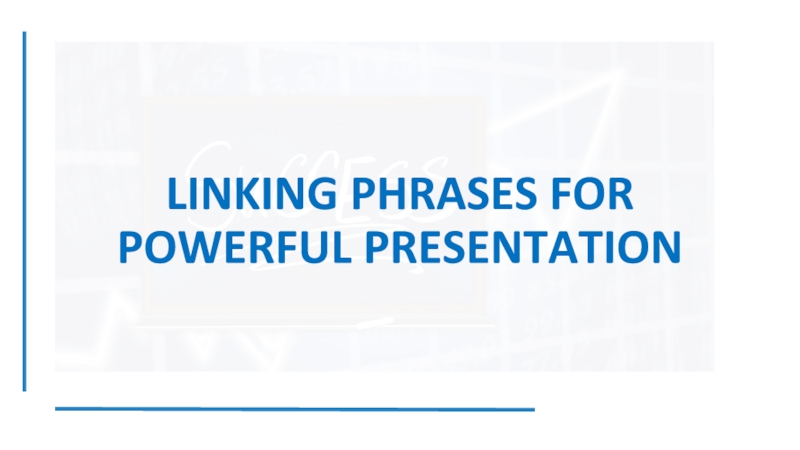
Слайд 2WHY USE LINKING PHRASES?
You signal the audience what you are going
to do.
You leave comments on your progress and the audience know where they are in the presentation.
Your linking phrases are like traffic lights that point the structure of your presentation.
Do not try to use all of the suggested phrases below – choose the most comfortable ones for you.
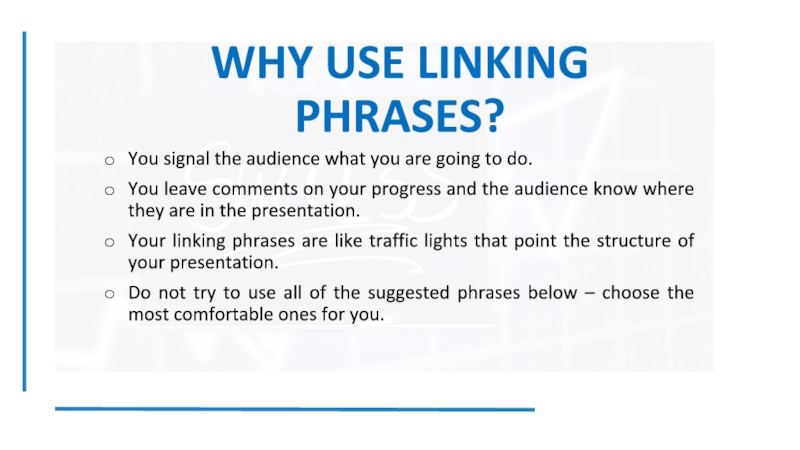
Слайд 3USEFUL LINKING PHRASES
Starting your first point
To start with …
First of
all …, then …
Firstly, …
Let me begin by saying …
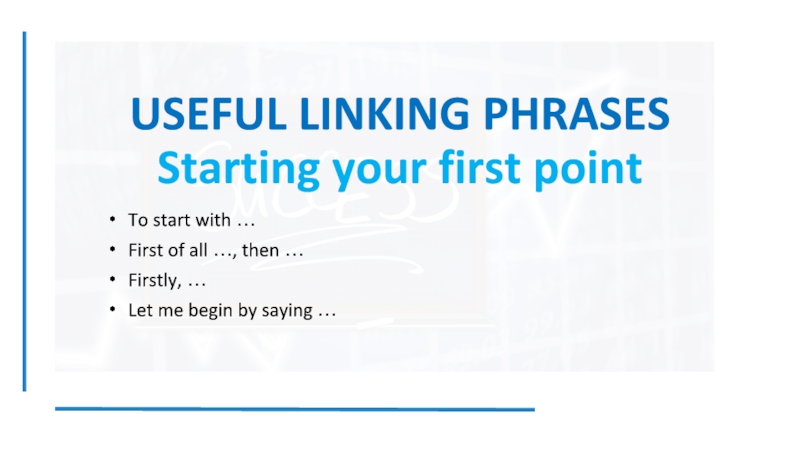
Слайд 4USEFUL LINKING PHRASES
Finishing a point
That’s all about …
Now, we have dealt
with …
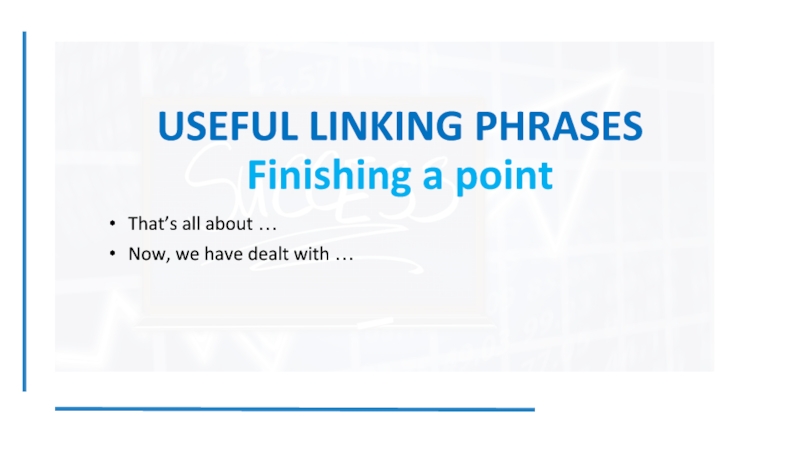
Слайд 5USEFUL LINKING PHRASES
Starting a new point
Now let’s turn to my next
point, which is …
Let’s move on now to …
The next point I’d like to make is …
Next we come to …
Turning now to …
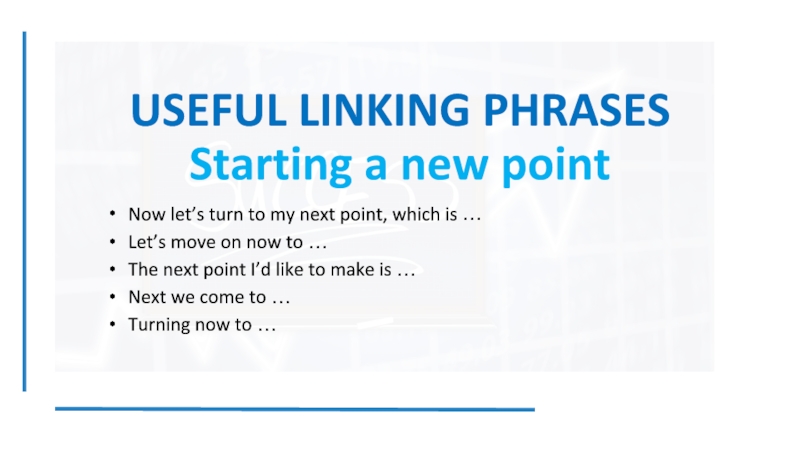
Слайд 6USEFUL LINKING PHRASES
Introducing your last point
And finally, …
Lastly, …
That brings me
to my last point, which is …
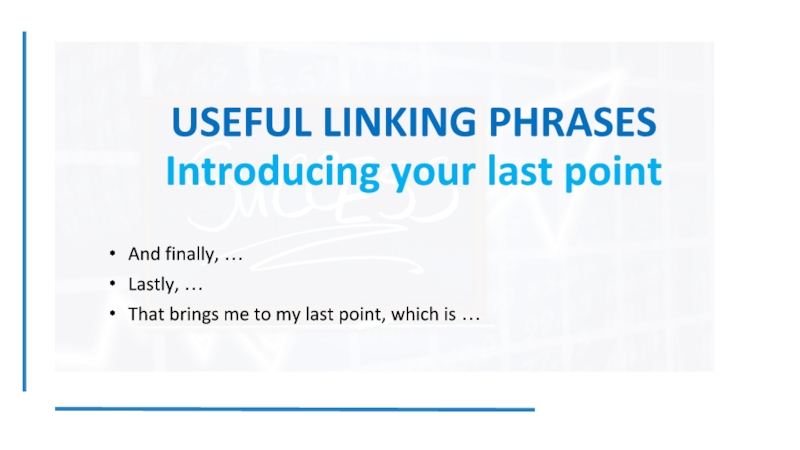
Слайд 7USEFUL LINKING PHRASES
Drawing audience’s attention
to the slides
If you look at
this first graph/table/pie chart/bar chart …
As you can see from the graph/table/pie chart/bar chart/slide …
Now let’s look at …
This graph/table/pie chart/bar chart is a good example/illustration of …
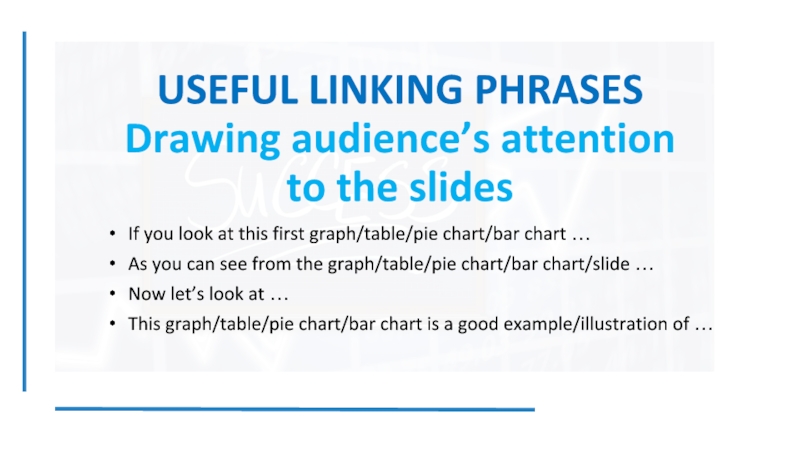
Слайд 8USEFUL LINKING PHRASES
Concluding
In a nutshell, …
Well, that brings me to the
end of my talk …
Thank you for your attention.
Thank you for listening.
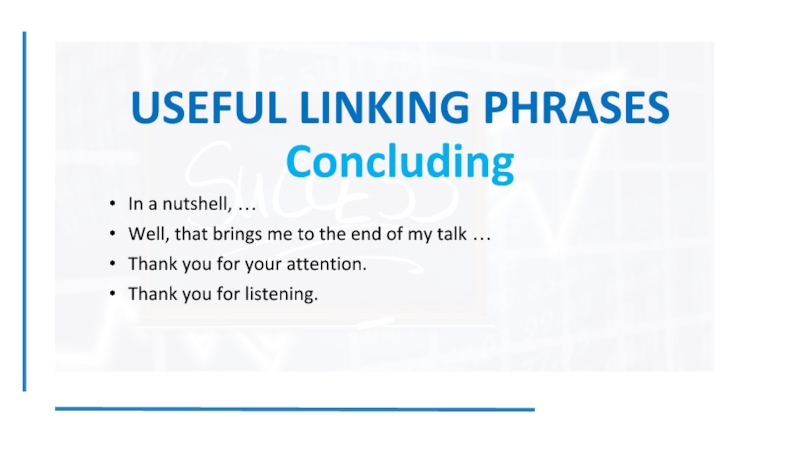
Нам бывает непросто выразить свои мысли лаконично и связно, когда мы общаемся на английском, пишем электронные письма по работе, отправляем сообщения иностранным друзьям. Сегодня расскажем, какие связующие выражения и вводные слова можно использовать, чтобы сделать вашу речь красивой, понятной и логичной.
Что такое linking words
Для начала нужно разобраться, что такое linking words и зачем их нужно знать.
Linking words — это связующие элементы, которые употребляют для логического перехода от одной мысли к другой. Они сделают вашу речь или письмо понятнее для англоговорящего читателя и обеспечат более высокий балл при сдаче любого экзамена. По-другому их называют discourse markers — маркеры беседы, связующие обороты речи.
Linking words могут быть выражены отдельными словами (например, however) или фразами (например, as a result), относиться к разным частям речи и употребляться в разных частях предложения.
| Часть речи | Слова-связки | Место в предложении | Пример |
|---|---|---|---|
| Союз | Like, because, although | В большинстве случаев ставятся в середине предложения, но могут быть и в начале, например although. | Although shopping online is quite cheap, delivery periods can be very long. — Несмотря на то, что покупать онлайн довольно дешево, сроки доставки могут быть очень долгими. |
| Предлог | Due to, despite the fact that, because | Ставятся перед существительными. | Young professionals are moving abroad because of low salaries in their native country. — Молодые специалисты переезжают за границу из-за низких зарплат в их родной стране. |
| Наречие | Therefore, indeed | Ставятся в начале предложения, выделяются запятыми. | The deadlines of the project are close. Therefore, we need to begin the launch of our product. — Сроки завершения проекта поджимают. Поэтому нам нужно запускать наш продукт. |
Linking words можно разделить на множество групп в зависимости от их функции (противопоставление, добавление новой информации, введение, заключение и т. д.). Давайте разберем каждую группу отдельно.
1. Purpose — цель написания
Эта группа наиболее важная, ведь в любой письменной работе мы указываем цель ее написания. Эссе, письмо другу или e-mail по работе — в большинстве случаев мы начинаем с объяснения, зачем мы пишем тот или иной текст. Например:
- in order to do smth, so as to do smth — чтобы сделать что-то;
- so that — чтобы;
- to that/this end — с этой целью.
I am writing to you so as to confirm my participation at the conference. — Я пишу вам, чтобы подтвердить свое участие в конференции.
I would like to confirm my participation at the conference so that there is no misunderstanding. — Я бы хотел подтвердить свое участие в конференции, чтобы не было недопонимания.
Zoologists are seeking to understand how animals communicate with each other. To that end, a new study has been launched. — Зоологи пытаются понять, как животные общаются друг с другом. С этой целью было начато новое исследование.
Хотите как можно скорее заговорить на английском? Тогда записывайтесь на бесплатный пробный урок.
2. Opinion and emphasizing — выражать мнение и акцентировать внимание
Это также одна из наиболее полезных групп linking words, так как во многих письменных заданиях необходимо выразить свое мнение по поводу той или иной идеи. Наиболее употребляемая фраза — in my opinion (по моему мнению). Как же можно заменить это выражение?
- in my view, to my mind, to my way of thinking — на мой взгляд, по моему мнению;
- personally, I believe that — лично я думаю, что;
- I feel strongly that — я глубоко убежден, что;
- I am inclined to believe that — я склонен полагать, что;
- it strikes me that, it seems to me that — мне кажется, что;
- as far as I am concerned — насколько мне известно.
To my way of thinking, in any occupation talent is more important than skills. — На мой взгляд, в любой профессии талант важнее умений.
I am inclined to believe that the problem of malnutrition in poor countries doesn’t depend on technological development. — Я склонен полагать, что проблема недоедания в бедных странах не зависит от развития технологий.
It strikes me that there is a larger issue in the team. — Мне кажется, что в команде есть еще более весомая проблема.
Иногда хочется подчеркнуть особую важность того или иного факта. Следующие слова помогут красочно, а главное, правильно это сделать:
- clearly, obviously — определенно, очевидно, бесспорно;
- needless to say — само собой разумеется;
- significantly, importantly — что особенно важно.
Clearly, if everyone were allowed to carry a gun, the crime rate would rise. — Бесспорно, если бы каждому было позволено носить оружие, уровень преступности возрос бы.
Importantly, the writer was being employed by the leading party when he wrote this work, and was therefore under pressure. — Что особенно важно, писатель работал на ведущую партию, когда написал данную работу, и поэтому был под давлением.
3. Listing facts and addition — перечисление фактов и добавление новой информации
В подтверждение вашему мнению зачастую необходимо привести ряд доказательств. Правильно и логично их выразить помогут следующие связующие слова и фразы, они всегда на письме выделяются запятой.
- firstly, first of all — во-первых;
- first — для начала;
- to start with, to begin with — прежде всего;
- in the first place — в первую очередь;
- secondly — во-вторых;
- thirdly — в-третьих;
- then, next — затем;
- afterwards, after that — после этого;
- finally — наконец;
- lastly — в заключение;
- last but not the least — последнее, но не менее важное.
To begin with, you should wash the wound in the cold water. Next, wrap a bandage around the cut. Lastly, put the patient in a comfortable position. — Прежде всего, вам следует промыть рану холодной водой. Затем обмотайте рану бинтом. В заключение, положите пациента в удобное положение.
Если вы хотите добавить какую-либо информацию к своему высказыванию, используйте подходящие слова-связки. Одна из типичных ошибок — это постоянное использование союза and (и) и also (также). В английском языке существует множество альтернативных слов и фраз:
- moreover, furthermore, in addition — более того (используются в начале предложения);
- besides — кроме того;
- as well as — так же, как и;
- coupled with — наряду с;
- not only … but also — не только …, а также и;
- not to mention, to say nothing of — не говоря уже о (используется, чтобы подчеркнуть новый аргумент);
- on top of that — сверх всего прочего, вдобавок ко всему;
- not only that, but — при этом.
That war caused suffering to millions of people worldwide, not to mention its impact on countries’ economy. — Эта война обрекла на страдания миллионы людей по всему миру, не говоря уже о ее влиянии на экономику стран.
The characters of the novel missed their train, and on top of that they were alone in the middle of nowhere. — Герои романа опоздали на поезд, и вдобавок ко всему они остались одни в глуши.
4. Contrast — противопоставление
Уметь правильно высказать противоположные мнения или факты также важно. Вместо обычного but (но) употребляйте следующие linking words:
- however — однако;
- on the one hand — с одной стороны;
- on the other hand — с другой стороны;
- having said that — вместе с тем, при этом;
- then again, that said — впрочем, хотя;
- yet — тем не менее (если стоит в начале предложения);
- despite smth, in spite of smth, notwithstanding smth — несмотря на что-либо;
- nonetheless, nevertheless — несмотря на это, все равно.
It is well known that the first landing on the Moon took place on July 20, 1969. Having said that, some people assert that it is a hoax. — Всем хорошо известно, что первая высадка на Луну была 20 июля 1969 года. При этом некоторые утверждают, что это ложь.
The manager says that a fire was the reason for what happened. Then again, it’s possible that he was paid to say this. — Менеджер утверждает, что причиной случившегося стал пожар. Впрочем, возможно, что ему заплатили, чтобы он так сказал.
Ann was not doing well in her physics course. Yet, she managed to get a high grade in the final exam. — Анна не очень хорошо училась по физике. Тем не менее ей удалось получить высокую оценку за итоговый экзамен.
Notwithstanding some members’ objections, the company went ahead with the plan. — Несмотря на возражения некоторых членов, компания продолжила идти по намеченному плану.
The research had its limitations, but it was important for us nevertheless. — В исследовании были свои ограничения, но оно все равно было важным для нас.
5. Comparing — сравнение
При сравнении двух точек зрения можно использовать следующие linking words:
- likewise, similarly — равно как и, таким же образом, аналогично;
- whereas — тогда как;
- conversely — и наоборот, в свою очередь;
- by contrast, in comparison — напротив, зато, в противоположность;
- although, even though — хотя;
- unlike — в отличие от.
Cars must stop at red traffic lights. Likewise, bicycles have to stop too. — Машины должна останавливаться на красный свет. Таким же образом должны поступать и велосипедисты.
People who aim to climb corporate ladders develop this trait while growing up. Conversely, people who search for stability acquire these values in their childhood. — Люди, которые стремятся идти по карьерной лестнице, приобретают эту черту характера пока взрослеют. В свою очередь, люди, которые ищут стабильность, получают эти ценности в детстве.
The marketing department suffers from absenteeism. By contrast, the call center employees are performing very well. — В отделе маркетинга наблюдается проблема отсутствия работников без уважительной причины. Зато сотрудники колл-центра работают очень хорошо.
The village festival went well, unlike the previous year when very few people came. — Сельский праздник прошел хорошо, в отличие от предыдущего года, когда собралось совсем мало людей.
6. Cause and consequence — причина и следствие
Важно уметь не только выражать свое мнение, но и аргументировать его. Многие изучающие английский язык делают ошибку, используя только because (потому что) и so (поэтому), тогда как существует множество синонимичных слов и фраз для выражения причин или следствий:
- Cause — причина
- since, as — так как;
- owing to the fact that, due to the fact that — в связи с тем, что;
- on the grounds that — исходя из того, что;
- in view of, in light of — принимая во внимание, исходя из;
- because of — из-за.
Since they had to wait for the train, they decided to have a cup of coffee. — Так как им нужно было ждать поезд, они решили выпить по чашке кофе.
Many members have objected to the proposal on the grounds that it would be too costly. — Многие члены не одобрили предложение исходя из того, что оно может быть слишком затратным.
In view of the late hour, the chairman decided to put off that discussion until the next meeting. — Принимая во внимание позднее время, председатель решил отложить обсуждение до следующего собрания. - Consequence — следствие
- consequently — следовательно;
- as a result — в результате этого;
- as a consequence — вследствие этого, как следствие;
- therefore — поэтому;
- for this reason — по этой причине, в силу вышесказанного;
- thus — так, таким образом.
Nowadays young adults receive a lot of help from their parents. As a consequence, they are remain unemployed longer than previous generations did. — Сегодня молодые люди получают много помощи со стороны родителей. Вследствие этого они остаются безработными дольше, чем представители предыдущих поколений.
We were unable to get funding. For this reason, we had to abandon that idea. — Нам не удалось получить финансирование. По этой причине нам пришлось оставить эту идею.
This plan will reduce waste, and thus cut costs. — Благодаря этому плану мы сможем сократить количество отходов и таким образом снизить расходы.
7. Example — пример
Помимо всем известного выражения for example (например) есть и несколько других вариантов linking words, позволяющих привести пример:
- for instance — например;
- to give an illustration — наглядно показать;
- such as — такой как, а именно;
- particularly, in particular, especially — в особенности.
Some birds migrate to avoid harsh winter climates. Swallows, for instance, leave the UK in early winter and fly south. — Некоторые птицы мигрируют, чтобы избежать суровых зим. Ласточки, например, ранней зимой улетают из Великобритании на юг.
To give an illustration of what I mean, let’s look at the case of obesity. — Для наглядности давайте рассмотрим проблему ожирения.
If you want to decrease your chances of having a heart attack, you should reduce your intake of meat, in particular red meat. — Если хотите уменьшить вероятность инфаркта, вы должны сократить потребление мяса, в особенности красного.
8. Condition — условие
Следующая группа linking words позволит добавить уточнение к уже сказанному или сделать оговорку:
- provided that, providing that, providing, on the condition that — при условии, что;
- in the event of, in case of — при возникновении, на случай (после ставится существительное);
- in the event that, in case — в случае, если.
He can borrow my car providing he doesn’t drive too fast. — Он может взять мою машину при условии, что не будет ехать слишком быстро.
It’s better to take an umbrella in case of rain. — Лучше взять зонтик на случай дождя.
In the event that trouble starts, lock all the doors! — В случае если начнутся волнения, закрой все двери!
Если вы хотите говорить грамотно, свободно выражать свои мысли и не делать ошибок на письме, запишитесь на курс «Практическая грамматика».
9. Introduction and conclusion — введение и заключение
В этой части разберем, какие слова-связки подходят для введения и заключения:
- Introduction — введение
Зачастую в начале письменных работ можно привести какое-то общеизвестное мнение или факт, таким образом представив тему, о которой пойдет речь. Употребляйте следующие фразы:
- it is widely believed that — многие считают, что / повсеместно считается, что;
- people often claim that — люди часто утверждают, что;
- some people argue that — некоторые люди приводят аргументы, что / утверждают, что;
- as a general rule, generally — как правило, обычно;
- on the whole, in general — в целом, в общем.
It is widely believed that the Earth is the only planet in our solar system where life is possible. — Считается, что Земля — это единственная планета в нашей солнечной системе, где возможна жизнь.
As a general rule, people who exercise regularly do not suffer from stress. But some people argue that they are still exposed to stress-related problems. — Как правило, люди, которые регулярно делают физические упражнения, не страдают от стресса. Но некоторые утверждают, что они все равно подвержены проблемам, вызванным стрессом. - Conclusion — заключение
- taking everything into account, all things considered — принимая все во внимание;
- as was previously stated — как уже отмечалось ранее;
- in conclusion — в заключение;
- to sum up — подводя итог;
- above all — главным образом, а главное;
- all in all — подводя итог изложенному выше, отметим.
All things considered, we can state that the general situation in the region is improving. — Принимая все во внимание, можно заявить, что общая ситуация в регионе улучшается.
To sum up, it is unlikely that mankind will ever bring an end to all wars. — Подводя итог, маловероятно, что человечество когда-либо положит конец войнам.
Above all, it is important to remember that natural resources are depleting. — Главное, важно помнить, что природные богатства истощаются.
All in all, the problem of civil war victims in these countries still remains. — Подводя итог изложенному выше, отметим, что проблема жертв гражданской войны в этих странах по-прежнему существует.
Теперь вы сможете более уверенно высказывать свое мнение, выражать несогласие или наоборот поддерживать точку зрения своего собеседника. Предлагаем вам повторить пройденный материал и пройти тест.
Тест по теме «Слова-связки в английском языке»
Скачать список лексики по теме «Слова-связки в английском языке» (*.pdf, 235 Кб)
© 2023 englex.ru, копирование материалов возможно только при указании прямой активной ссылки на первоисточник.






